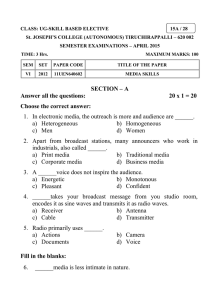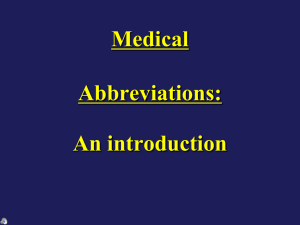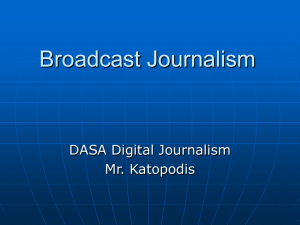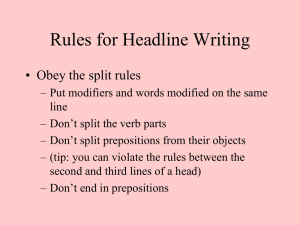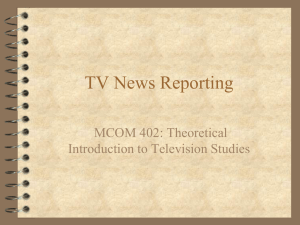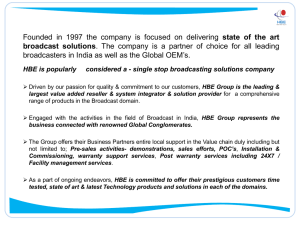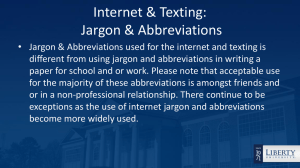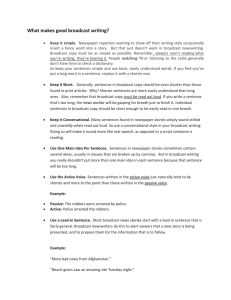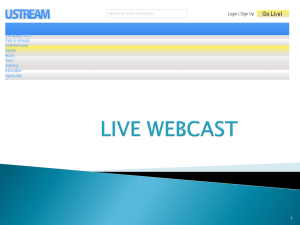PowerPoint Script Writing
advertisement
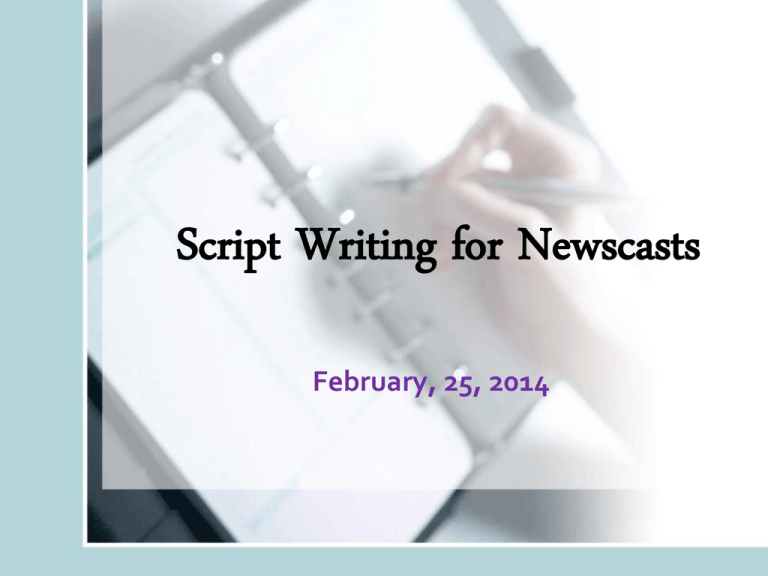
Script Writing for Newscasts February, 25, 2014 Objective •You will learn about the specialized skill of broadcast news script writing. •Take notes on the following Power Point presentation to file in the “production” section your notebook . Broadcast stories will… •Be shorter and simpler than print stories •Use present tense, active voice •Sound more conversational oUse “don’t” rather than “do not” •Start with an attention-getting “hook,” Broadcast leads… •5W/1H leads don’t work oToo much info at once oToo hard to hear oToo hard for an announcer to read •Use “soft” leads instead oThrow-away lead oAngle lead Throwaway lead Vacationers driving around the country this summer are likely to find lots of detours. The American Automobile Association says road repairs and construction are going on all over the nation. Angle Lead (hook) Planning to drive on your vacation this year? Get ready for lots of detours. The American Automobile Association says road repairs and construction are going on all over the nation. Some Things to Remember •Keep your sentences short •Keep subjects and verbs close together •Avoid introductory clauses Quote Attribution • Broadcast writers should avoid two common print formats: o putting the attribution after a quote or statement o identifying people by age, job title, etc. • It’s usually better to paraphrase quotes Quote Attribution •Listeners/viewers can’t see “quote marks” •Use direct quotes only when it’s important to repeat someone’s exact words. Quote Attribution RIGHT: The director of emergency disaster relief said all victims of the Florida hurricane are now back in permanent housing. Quote Attribution WRONG: “Victims of the Florida hurricane are all back in permanent housing,” said Scott Smith, director of emergency disaster relief. Broadcast Copy Guidelines •Double-space •CAPITALIZE EVERYTHING •Use an easy-to-read typewriter-style font (like Courier or Arial) Broadcast Copy Guideline •Put a slugline at the top left of each page oVacation Detours o30 seconds •Scripts are always in a dual column format 30 Apr 06 Name_______________________________ SAMPLE TV Spot Script Internet resource Class__________ 30 seconds Page 1 Kill Date: 31 Dec 06 Exercise # _______ VIDEO AUDIO (LS) STUDENT AT COMPUTER MUSIC: UP & UNDER ANNOUNCER (01:35) LOOKING FOR INFORMATION? CHECK OUT THE INTERNET. (MS) COMPUTER MONITOR SCREEN BUT BEWARE ... SOME INTERNET INFORMATION IS OFF LIMITS. (02:05) DON’T VENTURE INTO THE DARK SIDE OF THE INTERNET, (CU) STUDENT TYPING ON COMPUTER ESPECIALLY TO HOME PAGES WITH SEXUALLY EXPLICIT (LIGHTING CHANGES TO RED) MATERIAL. (03:00) YOU MAY BE ABLE TO GAIN ACCESS TO THESE SITES, BUT (CU) KEYBOARD THE COMMANDANT HAS PLACED THEM OFF LIMITS. (03:43) ALL DINFOS COMPUTERS KEEP A LOG OF THE SITES YOU (ECU) COMPUTER SCREEN VISIT ... A LOG OFFICIALS COULD USE TO TRACK YOU DOWN. (04:15) (MORE) 30 Apr 06 Name_______________________________ SAMPLE TV Spot Script Internet resource Class__________ 30 seconds Page 1 Kill Date: 31 Dec 06 VIDEO Exercise # _______ AUDIO (CU) STUDENT’S FACE (STRIP LIGHTING ON FACE) (04:37) (MORE) (CU) COMPUTER MONITOR (PICTURE BLURS AND TURNS TO BE SURE TO PULL THE PLUG ON BAD NET SURFING HABITS STATIC) ... (05:12) BEFORE SOMEONE PULLS THE PLUG ON YOU. KNOW AND OBEY DINFOS INTERNET RULES. MUSIC: FADE UP AND OUT TO TIME ### Broadcast Guidelines • Omit datelines • Work the location into the lead • Use an end mark (- 30 -) or (# # #) to clearly designate the end of the story o Time = Length o 20 seconds = 5 lines (45 words) o 30 seconds = 8 lines (65 words) o 60 seconds = 16 lines (125 words) Punctuation • Avoid complex punctuation • Listeners/viewers can’t see it! • Punctuation is only there to help the announcer read the story o Commas (,) and periods (.) o Ellipses (…) and dashes (--) o Quotation marks (“__”) o Question marks (?) Complex Punctuation •colons (:) •semicolons (;) •percentage signs (%) •dollar signs ($) •ampersands (&) Unconventional punctuation •Use ellipses (…) to indicate dramatic timing, like a long pause. Example: While workers were arriving early this morning … a deafening explosion shook the plant.” Using Abbreviations •Eliminate most abbreviations (even AP Style abbreviations for states) •Use only well-known abbreviations, like C-I-A and NASA. •Don't use abbreviations unless you want them to be read as abbreviations Using Numbers •Numbers can be hard to follow, so • try to avoid using them If you do need to use numbers in your broadcast copy… oSpell out numbers under 12 oUse numerals for 12 to 999 oWrite “one thousand” instead of 1,000 Using Numbers • Simplify complex numbers. o Round numbers off o Use modifiers such as…approximately, almost, more than, about Example: $2,001,859.00 becomes “slightly more than two (m) million-dollars.” More on numbers • Spell out the symbols for dollars and cents • 29-dollars or 60-cents • Write fractions as words and hyphenate them • two-thirds • Use hyphens to link related numbers • “For more information, call 1-800-5-5-5-1-2-1-2” Time references • Use present tense • Avoid repeating “today” – say “early this morning,” or “this afternoon” instead • Use terms that listeners can relate to Example: “One lane of the freeway will be closed during the morning rush hour.” Names & Titles • Use the title before the name • If the title is long, break it up or shorten it • Never begin sentences with a name • If the person is well-known, like President Bush, you can omit the first name
